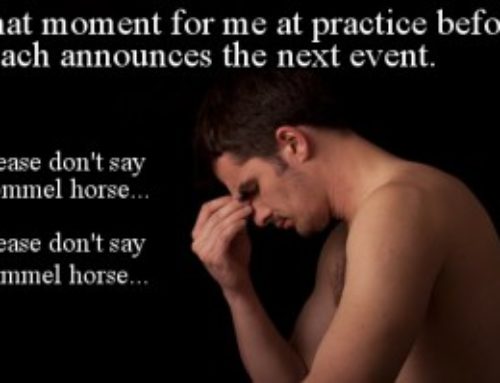CONCENTRATION
Focusing on the Right Thing at the Right Time
What do I mean by concentration? I mean focusing totally on the business at hand and commanding your body to do exactly what you want it to do.
– Arnold Palmer, Professional Golfer
The most important thing is focus. You must divorce yourself from what is going on around you. There’s nothing except you, the ball and the basket.
– Calvin Murphy, former basketball great
If you take it easy for 10 minutes, it takes a long time to get it back. Like everything else, concentration is a habit.
– Merlin Olsen, Former NFL Tackle
Concentrate! Keep your head in the game! Stay focused. You’ve probably heard your coach, teammates and even yourself repeat these and similar phrases over and over again. The ability to maintain concentration while immersed in the pressure of competition is critical to optimum performance. If you lose your focus to a sellout crowd, a bad scoring or nagging self-doubt, you are not just battling your opponent, you’re battling yourself. Although we may not always be able to eliminate distractions, successful athletes take control of their performance by blocking out unnecessary distractions while responding to important cues.
What is Concentration?
Concentration is paying attention to the right things at the right time. It is the ability to “park” your mind on the task at hand and nothing else. As an athlete, What are the things outside of yourself (external), such as sights, sounds, actions that you need to pay attention to and when? What are the things inside of you (internal) that you need to focus on? When? As you make a fast break, is that the time to be thinking about how your legs feel as you bound down the court? You’re poised to shoot a foul shot, do you use this opportunity to recall every air ball you’ve ever thrown? When your playing is effortless, what are you concentrating on? When do you usually get caught off guard? What draws your focus away from where it needs to be and brings it back? By identifying the attentional demands of your sport, event, or position you can direct your focus more effectively. If you can recognize your own attentional strengths, challenges and preferences, you can antipate and prepare yourself for critical performance situations. Change favors only the prepared mind. Prepare to excel by preparing to concentrate.
How Am I Doing? Rating Your Own Concentration Skills
Answer the following questions to help you determine if concentration is an important mental skill for you to work on.
0= Never 1= Sometimes 2= Almost Always
______ 1. I often use cue words and triggers to keep me focused on my performance.
______ 2. I know what I need to do to get in the right frame of mind to compete.
______ 3. I can jump from one thought to another or one task to another without losing my train of thought.
______ 4. If a competition or practice goes into overtime, my levels of intensity and concentration remain consistent.
______ 5. I am very good at participating and responding to an opponent’s actions.
______ 6. I can put aside non-sport related thoughts while training and competing.
______ 7. There are times when I get so absorbed in what I am doing that I don’t notice what else is going on around me.
______ 8. During breaks in play, I can relax and recover but when I am competing I am completely “in the moment.”
______ 9. I do not get flustered or confused when a lot of different things are going on at once like several people speaking at the same time or when I need to make a turn at a busy congested intersection.
_____ Total (Add up your scores from all 9 items)
12-18: Excellent! Your score indicates you are skilled at focusing on the necessary elements of your performance and you can maintain or redirect that focus when the situation dictates a change. Practice some of the exercises in this chapter to experiment with some additional strategies.
6-11: You do have the ability to focus, refocus, and maintain your focus but you appear to be stronger in some areas than others. Use the exercises at the end of the chapter to balance and strengthen your attentional style.
0-5: At times you may feel overwhelmed by the demands of competition. Take this opportunity to become more familiar with the attentional demands of your sport and systematically apply the following suggestions and exercises to minimizing distractions and maximize your effort.
Dimensions of Attentional Style
(Adapted from Nideffer and Sharpe, 1978)
Sport Psychologist Bob Nideffer recognized that concentrating effectively depends on both sport demands and attentional skills or styles. Below is his model showing the four different ways athletes have been found to focus their attention. Understanding the four different types of attention, and learning about your own strengths and areas to improve are the first steps toward developing your own concentration skills.
Note that there are two dimensions of attention, width (broad – narrow) and direction (internal – external).
1. Width (broad – narrow) refers to how many things you are paying attention to at once. When your attention is broad, you are attending to many things. When you have a narrow attentional focus, you are paying attention much more specifically to one or a very few things. A football quarterback, scanning the field for receivers, has to have broad attention, while a golfer getting ready to putt is likely to have a more narrow focus of attention.
2. Direction (internal – external) is defined by whether your attention is focused internally toward your own thoughts and feelings, or externally on the events in your environment. A diver, imaging her upcoming dive in her head, has an internal focus, while a baseball player up to bat, has external focus as he watches the pitch coming in.
These two dimensions are somewhat different. The Width dimension is on a continuum, while the Direction dimension is either-or —- you can’t be half-internal, half-external!
External
Football quarterback scanning the field Golfer preparing to putt
Broad <————————————————————————————->Narrow
Athlete mentally preparing whole competition plan Diver imagining next dive
Internal
The model below describes in more detail how the two dimensions interact, while also providing the advantages and disadvantages of each type of attentional focus.
| Broad | Narrow | |
| Internal | Broad-Internal
“Analyze Your Inner ‘Big Picture’” Good for dealing with a lot of information at the same time. Essential for developing a game plan or strategy. Mistakes are due to over-analysis. Athlete thinks too much about the wrong, task-irrelevant things. |
Narrow-Internal
‘Focused Inner Thought”
Good at looking in on a single thought or word. Essential for body awareness, energy management and mental imagery. Mistakes are due to “choking.” Athletes become distracted by internal states, become inflexible and lock up their concentration. |
| External | Broad-External
“Assess Total Environment” Good for quickly assessing the situation. Essential for being aware of all cues in the environment. Mistakes are due to paying attention to irrelevant and or distracting cues. May be faked out easily. |
Narrow-External
“Single Object Focus” Good for locking in on one or two primary targets. Essential for blocking out distractions. Mistakes are due to athletes becoming too narrow in their focus, thereby missing vital cues. |
To make use of the information in this model, first you must determine which of these four attentional styles is a strength and which areas do you need additional assistance developing. Every athlete has his or her own strengths and weakness; some athletes are very good at one dimension and weak on the others, while other athletes may be somewhat skilled in all dimensions. We will talk more specifically about ways to develop your attention later on.
Now its time to assess gymnastics. Which of Nideffer’s attentional skills is top priority in terms of sport demand and your focusing strengths? You will find on the next page a diagram that can help you systematically review your own competition situation and determine which attentional dimensions you need.
Concentration Exercise #1:
What are Gymnastics Concentration Demands and What Attention Dimension is Best?
| Critical Situation | Type of | Attention | Dimension | Required |
| External | External | Internal | Internal | |
| Broad | Narrow | Broad | Narrow | |
Concentration Exercise #2:
Focusing Under Pressure
Below are several ideas for ways to practice focusing under pressure.
Change of Focus Drill. Select a period of time (30 seconds-2 minutes) during which you direct your focus to only one aspect of the performance or skill. Change focus during the following time interval.
For example:
1. Footwork- How do your legs feel?
2. Arm Position- Where are your arms?
3. Breathing- Are you breathing easily?
Stimulation Training. Recreate the competitive situation in practice. Simulated competition experiences enable you to become so familiar with the competing stimuli that you are no longer distracted by it.
Distraction Drills: Follow performance routine despite verbal and visual distractions deliberately performed by teammates and coach. For example, a tennis player may play a practice match while an audio recording of crowd noises is played over the loud speaker, or the coach may instruct the line judges to deliberately make bad calls, thereby testing the athletes’ ability to recover from the unexpected.
Quality Practice. This workout design is short and intense. You must be ready as soon as practice begins and warm-up ends. Only one misplay is allowed. After two missed chances you must stop the practice of that skill.
Concentration Exercise # 3a:
Establishing a Refocus Routine
1. Recognize distractions. Identify the factors in gymnastics which are likely to distract your attention or draw focus away from crucial elements of performance.
2. Select your focus. Identify the factors in your performance which require your concentration.
3. Prepare to concentrate. Concentration requires a passive, relaxed mindset, there it is helpful to reduce stress and anxiety. Too much stress destroys attentional focus.
4. Create concentration cues. Use attentional “cues” or “triggers” as reminders to concentrate. These words, images or actions should be simple, positive and personally meaningful.
5. Create your own refocusing routines. Anticipate possible distracters and decide how you will respond to them. These responses are your refocusing routines. Practice your refocusing routines until they are effective and instinctive. If you plan what you will do between routines, moves, performances you will find you can bring your concentration under control. Refocusing routines reduce uncertainty and decrease susceptibility to distractions.
During your training sessions over the next week, make a mental note of the distractions which interfere with your concentration. Record this information in the graph on the next page. Do this immediately after practice or during a break.
| Distractions | Coping response to minimize negative impact | Cue word or trigger |
| Abusive comment by spectator | Centering breath, followed by positive affirmation | “Play my own game” |
| Opponent scores well | Offer encouragement to teammates, adopt ready position | ‘Turn up the heat!” |
| Negative thoughts and self-doubts | Immediately use thought-stopping technique, replace with positive, productive affirmation | Visualize big red stop sign |
Concentration Exercise #3b:
Another Way to Plan Your Refocusing Routine
Use the situations provided below or supply your own as you anticipate and plan for the unexpected. (Adapted from Orlick, 1986)
Refocusing Plan
If the start is delayed I will……….
If my equipment fails, I will………..
If the crowd is boisterous and negative, I will…………
If I make a mistake, I will…………
If I must perform under non-ideal conditions, I will………..
Other possibilities…………..



Of course, what a splendid website and educative posts, I will bookmark your website.All the Best!